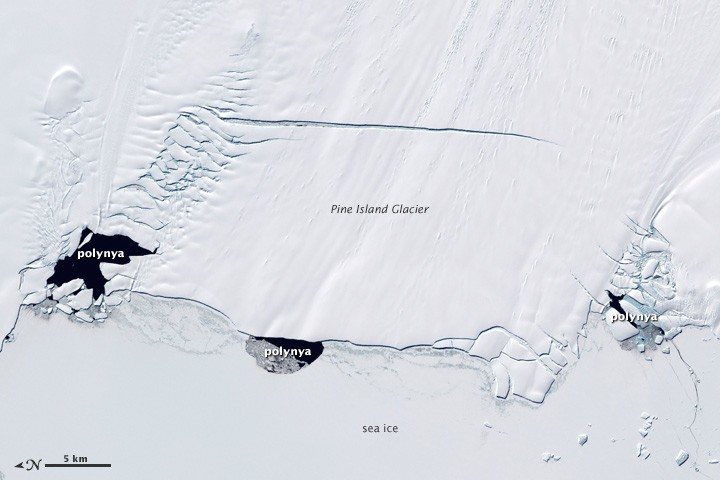
(Photo: Wikimedia Commons/NASA's Earth Observatory)
Researchers were baffled at the huge hole that sometimes opens over the Antarctic Weddell Sea for decades. It was so huge that it exposed the dark, cold water below it. Finally, they found the answer as to why the hole appeared.
Mysterious Hole in the Antarctic Ice Resolved
Since it was first observed in 1974 and doesn't recur yearly, scientists are unsure of the precise circumstances for it to occur. In 1974, the enormous hole was roughly the size of New Zealand. It had brief, feeble reappearances in 1975 and 1976 before scientists thought it might be gone for good.
However, it reappeared in 2016 and 2017, with a hole in the ice the size of Maine. Gradually, an answer has come together.
The answer to the 50-year mysterious phenomena was determined using satellite photography, autonomous instrumentation on floating platforms, hat-wearing seals, and computer modeling. Researchers also included wind-pulling water layers to form an Ekman spiral.
"Ekman transport was the essential missing ingredient that was necessary to increase the balance of salt and sustain the mixing of salt and heat towards the surface water," said oceanographer Alberto Naveira Garabato of the University of Southampton in the UK.
Scientists got to work because the 2017 Maud Rise polynya was the largest and longest-lasting instance of the phenomenon since the 1970s. A synthesis of the information gathered by the previously stated sources showed that several factors had to coincide precisely to make the polynya.
One contributing element was an upwelling of warm, incredibly salty, water caused by a powerful circular current around the Weddell Sea in 2016 and 2017.
"This upwelling helps to explain how the sea ice might melt," explained oceanographer Fabien Roquet of the University of Gothenburg in Sweden.
However, when the sea ice melts, the surface water gets fresher, which should limit the mixing. Therefore, another process needs to be in place for the polynya to continue. Somebody has to be adding extra salt to the mixture.
ALSO READ: 700 Emperor Penguin Chicks Jump From 50-Foot Ice Cliff in Antarctica; Here's Why They Do This
What Is Maud Rise Polynya?
The Maud Rise polynya is derived from the name of the buried mountainous structure that develops regularly in early spring and sometimes in winter. The curvature of the seafloor "causes the ocean current driven by the Weddell Gyre to bring warm water up to the upper layer of the ocean and causes the sea ice to melt," according to Joey Comiso, an emeritus scientist at NASA's Goddard Space Flight Center.
The Maud Rise polynya reached massive proportions in the winter of 2017, expanding from 9,500 square kilometers in mid-September to around 80,000 square kilometers by late October (almost the same area as South Carolina).
There has long been research on how polynyas may develop, flourish, and survive Antarctica's harsh winters. Intense cyclonic winds-some as intense as hurricanes-have been implicated in recent studies as the cause of open-ocean polynyas. Cyclonic winds "drag the floating sea ice in opposite directions around the cyclone center, creating the opening," according to Diana Francis, a scientist at New York University Abu Dhabi and the study's principal investigator.
Certain winters see substantial heat and moisture transfer from mid-latitudes to Antarctica via air circulation, which opens the door for massive cyclones to form over the sea ice. For instance, in the winter of 2016, a storm crossed the sea ice before a tiny, transient polynya developed.
Francis stated that the heat transfer in 2017 was more robust and steady than in 2016. She added that the more frequent and powerful storms increased the magnitude of the 2017 event and prolonged the duration of the polynya.
RELATED ARTICLE: Arctic Ocean Has Been Getting Warmer Decades Than The Records Suggest, Study Says
Check out more news and information on Antarctica in Science Times.


![Some Brain-Injured Patients Who Died After Life Support Was Withdrawn May Have Survived, Recovered Some Level of Independence 6 Months After Injury [Study]](https://1721181113.rsc.cdn77.org/data/thumbs/full/53613/89/56/50/40/some-brain-injured-patients-who-died-after-life-support-was-withdrawn-may-have-survived-recovered-some-level-of-independence-6-months-after-injury-study.jpg)











